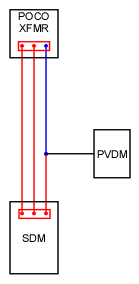The effect in terms of excess current in the tap to load section of the tapped conductor will vary considerably with the location of the tap.
A tap close to the service will have the least effect on the current in the tap-to-load section of the conductor while a tap close to the load will have the largest effect, but on a smaller length of conductor.
As Smart$ stated, non-compliant regardless.
In the scenario of exporting power, the effect is reversed.
During export of power, backfeeding the service transformer:
Closest to the load = least imbalance, spread out over a long length
Closest to the utility source = most imbalance, but over a local length only
During on-site consumption of PV power + utility power (as discussed):
Closest to the utility source = least imbalance, spread out over a long length
Closest to the load = most imbalance, but over a local length only


